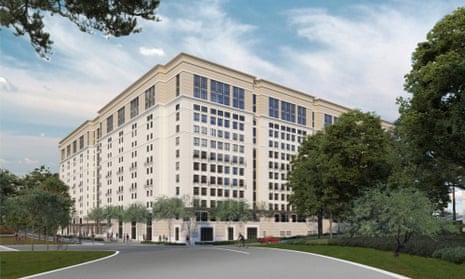Sometimes, an idea seems so transparently and hyperbolically awful that you wonder if there is some secret brilliance to it. Such is the one for Munger Hall, the plan to build a dormitory at the University of California, Santa Barbara, where 94% of the 4,500 students will live in rooms without windows. Glowing screens that mimic sunlight are promised instead.
Some contrarian minds have tried to justify it, not least Charlie Munger, the 97-year-old billionaire who is the building’s donor and designer. He has compared the rooms to the berths inside cruise ships, a view that seems to ignore the difference between a short holiday, where your windowless cabin might be compensated for by the tropical paradises you visit, and an academic year.
The university has tried to make a virtue of the fact that students won’t have to go to the trouble of opening windows as they will get all the oxygen they need from a ventilation system. One urban planner justified the project as a response to the shortage of residences caused by nimbies.
The problem with this argument – let’s address housing need by making dwellings ever more miserably confined – is that it knows no bottom. Perhaps in the future students can be cryogenically frozen at night, then efficiently stacked using the storage and retrieval systems of an Amazon distribution centre, before being defrosted in time for their morning slurp of laboratory-made food substitute. But we don’t have to go that far to see what a shrivelled vision of humanity it is that gives no value to sunlight or to the rhythms of night and day and where this approach is willingly accepted by a university seemingly because it comes with a large dollop of cash. On reflection, Munger Hall is as terrible as it looks.
An exhibition too far

An “international PR firm” sends me “a special invitation to Moscow”. It wants me to see “a mesh-framed eco-pavilion filled with plastic water bottles”, installed at the Garage Museum of Contemporary Art. The pavilion, designed by a Moscow-based practice called Lipman Architects, is about “inviting conversation around topics such as material recycling and the environmental impact of temporary architecture”. But the climate emergency is surely past the point where “inviting conversations” will do much good. You will also have spotted the conceptual flaw in organising 3,000-mile, carbon-intensive round trips for journalists to witness this worthy work.
Ghastly gentrification

Plantation Wharf is a residential development in Battersea, south-west London, which includes addresses including Cotton Row and Molasses Row. Now, 26 years after it was built, the local MP, Marsha de Cordova, has called for the names to be changed. “They’re quite sickening and in many respects almost glorify what was an abhorrent enslavement of Africans,” she says. When it comes to cloth ears, it is hard to beat the marketing blurb for Plantation Wharf that local councillor Aydin Dikerdem found on the website of estate agent Eden Harper. Alongside breathy tales of local celebrities, it tells of “a harmless chap of anomalous habits” who lived on a dilapidated barge. One night, “with plans afoot for gentrification, a mystery blaze destroyed the eyesore vessel and the eccentric inhabitant was never heard of or seen ever again”.
What a piquant tale this is, what a value-enhancing piece of local colour: a man made homeless and possibly burned to death in the interests of real estate. Perhaps the development’s “expansive glazed sections”, as Eden Harper calls them, offer good views of the scene of the crime.

